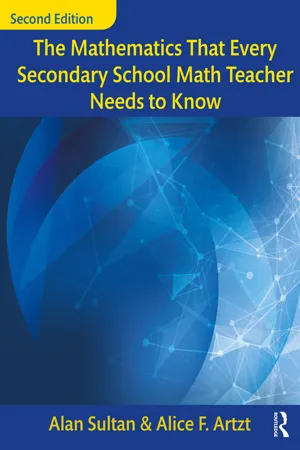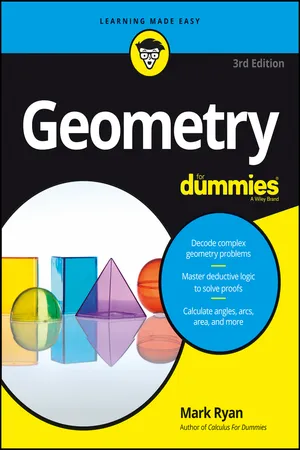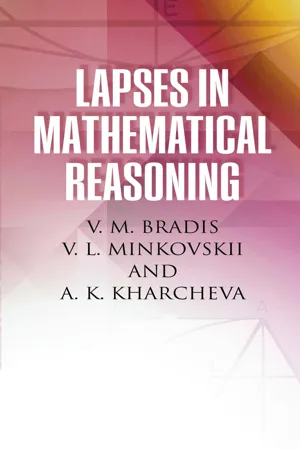Mathematics
SSS Theorem
The Side-Side-Side (SSS) theorem is a principle in geometry that states if the three sides of one triangle are congruent to the three sides of another triangle, then the two triangles are congruent. This theorem is a fundamental concept in proving the equality of two triangles based on their side lengths.
Written by Perlego with AI-assistance
Related key terms
5 Key excerpts on "SSS Theorem"
- Alan Sultan, Alice F. Artzt(Authors)
- 2017(Publication Date)
- Routledge(Publisher)
The first result we talk about is something we are all familiar with: If three sides of one triangle have the same lengths as three sides of another triangle, then the triangles are congruent. That is, all their corresponding parts match! This is quite remarkable since we have said nothing about the angles of these triangles. Yet, this follows immediately from the Law of Cosines.Theorem 5.2 (SSS = SSS) If the three sides of triangle ABC are congruent to the three sides of triangle DEF, then the triangles ABC and DEF are congruent .Proof . Let us assume that the sides that match are a and d, b and e , and c and f . (Refer to Figure 5.2 .) So a = d, b = e , and c = f . From equation (5.8) we have thatcos C =a 2+b 2-c 22 a b(5.11) and using the same law in triangle DEF with the corresponding sides, we havecos F =.d 2+e 2-f 22 d e(5.12) Since a = d, b = e , and c = f we can substitute them in equation (5.11) to getcos C =d 2+e 2-f 22 d e(5.13) and we see from equations (5.12) and (5.13) thatcos C = cos F .(5.14) It follows that ∡C = ∡F .In a similar manner using the other versions of the Law of Cosines, equations (5.9) and (5.10) , we can show that ∡A = ∡D and ∡B = ∡E .Thus, if three sides of one triangle are equal to three sides of another triangle, then the corresponding angles match, and so the triangles are congruent.Note: In the proof of Theorem 5.2 (refer to equation (5.14) ), we used the fact that, if cos C = cos F , then ∡C = ∡F . While you may have accepted this, much more is involved in this statement than meets the eye. For now, we will use this fact continually and ask you to accept it. But, we will examine the reason behind it in a later section on technical issues. We now turn to a corollary of our SSS congruence theorem.Corollary 5.3 (HL = HL) Two right triangles are congruent if the hypotenuse and leg of one triangle are congruent to the hypotenuse and leg of the other triangle .Proof . In Figure 5.3 we see two right triangles where the hypotenuse and leg of one have the same lengths as the hypotenuse and leg of the other.We will show the third sides of the triangles have the same length. By the Pythagorean Theorem,Figure 5.3- eBook - ePub
- Mark Ryan(Author)
- 2016(Publication Date)
- For Dummies(Publisher)
The triangles on the left are congruent, but the statement is false. Visualize how you’d have to move to align it with — you’d have to flip it over and then rotate it. On the right, I’ve moved so that it lines up perfectly with. And there you have it:. All corresponding parts of the triangles are congruent:,,, and so on. © John Wiley & Sons, Inc. FIGURE 9-1: Check out how these two congruent triangles stack up. SSS: Using the side-side-side method SSS (Side-Side-Side): The SSS postulate states that if the three sides of one triangle are congruent to the three sides of another triangle, then the triangles are congruent. Figure 9-2 illustrates this idea. © John Wiley & Sons, Inc. FIGURE 9-2: Triangles with congruent sides are congruent. You can use the SSS postulate in the following “TRIANGLE” proof: © John Wiley & Sons, Inc. Before you begin writing a formal proof, figure out your game plan. Here’s how that may work. You know you have to prove the triangles congruent, so your first question should be “Can you show that the three pairs of corresponding sides are congruent?” Sure, you can do that: Subtract and from and to get the first pair of congruent sides, and. Subtract from and to get the second pair of congruent sides, and. Cut congruent segments and in half to get the third pair, and. That’s it. To make the game plan more tangible, you may want to make up lengths for the various segments. For instance, say AG and EG are 9, NG and LG are 3, AR and ET are 8, TR is 3, and NI and LI are 8. When you do the math, you see that and both end up with sides of 4, 5, and 6, which means, of course, that they’re congruent. Here’s how the formal proof shapes up: © John Wiley & Sons, Inc. Note: After SSS in the final step, I indicate the three lines from the statement column where I’ve shown the three pairs of sides to be congruent. You don’t have to do this, but it’s a good idea. It can help you avoid some careless mistakes - eBook - ePub
- Walter Meyer(Author)
- 2022(Publication Date)
- Chapman and Hall/CRC(Publisher)
2 The Euclidean HeritageDOI: 10.1201/9780429198328-2Our main objective in this chapter is to study how some key theorems in Euclidean geometry arise from the axioms in Chapter 1 . To make quicker progress, we relax slightly the degree of rigour used in the last section of Chapter 1 , to a standard closer to Euclid's Elements.The Side-Angle-Side (SAS) Axiom will play a huge role and, in the third section, Euclid's Parallel Axiom. Students with a firm grasp of how proofs are constructed in geometry may go quickly through this. Although the theorems of this chapter are old, our applications span the from ancient to modern.Prerequisites:- Some intuitive understanding of geometry
- Chapter 1
Section 1. Congruence
To say that figures are congruent means, in non-technical language, that they have the same size and shape even though they may be in different positions (Figure 2.1 ). There is a more to say to make this precise and useful, so in this section, we will flesh this out with a detailed theory for triangles in the plane. However, the attention to triangles shouldn't obscure the fact that the concept also applies to figures other than triangles. It is entirely reasonable to ask whether two quadrilaterals are congruent and to ask what evidence would convince us of it. The triangle theory can help with quadrilaterals, pentagons, and so on. You might like to think about whether it helps us with curved figures.Figure 2.1Two congruent triangles.It is quite possible that the human mind does three-dimensional congruence checking to recognize familiar people or objects. If you are sitting in front of your computer, how do you know it is your computer and not the microwave oven? The computer has a certain size and shape which is recorded in your mind. Even if you are seeing it from a new angle right now—an angle you have never seen if it has tipped over—you can somehow compare the current view to the recalled image and tell that they differ just by position. - eBook - ePub
Making Sense of Mathematics for Teaching High School
Understanding How to Use Functions
- Edward C. Nolan, Juli K. Dixon, Farhsid Safi, Erhan Selcuk Haciomeroglu(Authors)
- 2016(Publication Date)
- Solution Tree Press(Publisher)
In addition to supporting connections between algebraic and graphical representations of functions, transformations are useful when exploring congruence and similarity. Students see that if a sequence of rigid motion transformations can map one figure to another, then the two figures are congruent. If the sequence includes a dilation, then the shapes are no longer congruent; however, they are similar.Figure 3.10: Exploration of a parent function.Exploring Congruence Through ProofHow do you develop an understanding of deductive reasoning in geometry? Consider the task in figure 3.11 .Figure 3.11: Proving triangles congruent task.What could have happened for two triangles to have three corresponding parts the same yet be different triangles? As you probably know, you do not need to be given the measures of all corresponding angles and sides of two triangles to prove congruence of triangles. This is an important distinction for students as they learn to develop proofs—learning what information is necessary and what information is sufficient to use congruence theorems. You likely know the different triangle congruence theorems—side-side-side (SSS), side-angle-side (SAS), angle-side-angle (ASA), and angle-angle-side (AAS). Helping students determine how these relationships can be used to create proofs is an important factor in developing reasoning in geometry. Each of the congruence theorems need only three congruent corresponding parts. Since the task in figure 3.11 has three pieces, can you prove the two triangles should be congruent?You may have decided to start thinking about this task by drawing a triangle that represents the given information (see figure 3.12 ).Figure 3.12: Drawing of ΔABC.This triangle matches the given information but is not the only possible triangle that could be drawn from these dimensions. This task is an example of the side-side-angle (SSA) relationship (where the length of two sides are congruent as is one of the angles that is not composed of the given sides), which is not a congruence theorem. While you may create another triangle congruent to the one in figure 3.12 based on the given information, there is another possibility. Consider how you might build a triangle using the given information. You could start with the angle constructing a 52° angle at point C (see figure 3.13 - eBook - ePub
- V. M. Bradis, L. Minkovskii, A. K. Kharcheva(Authors)
- 2016(Publication Date)
- Dover Publications(Publisher)
III. Stories, with Explanations, of Causes of Erroneous Reasoning63. Similar triangles with equal sidesTake two similar scalene triangles and denote the sides of the first in the order of increasing size by the letters a, b, c (a < b < c), and the corresponding sides of the second by the letters a1 , b1 , c1 . By virtue of proportionality of the corresponding sides of similar polygons we have: a1 = aq, b1 = bq, c1 = cq, where q is the coefficient of proportionality, and therefore a1 < b1 < c1 .If q = 1, then all the sides of the two triangles are respectively equal, and the triangles are congruent. The congruence of the triangles is thus a special case of similarity.It may seem, that if the triangles are similar, but not congruent, then they have no equal sides. The erroneousness of such a conclusion is shown by a simple consideration of triangles with the sides 8, 12, 18 cm, and 12, 18, 27 cm. The sides of the second are one-and-one-half times as large as the corresponding sides of the first, and therefore the triangles are similar (but not congruent). As we see, these two triangles have two pairs of respectively equal sides.We shall establish the conditions which have to be satisfied by two similar, but not congruent, triangles having two pairs of respectively equal sides.Suppose that q > 1. The smallest side a of the first triangle (with the sides a, b, c) is less than the smallest side a1 of the second triangle (with sides a1 = aq, b1 = bq, c1 = cq), and cannot be equal to any of the sides of the latter.The middle side b of the first triangle may be equal only to the smallest side a1 of the second triangle (since b is less than b1 = bq and much smaller than c1 = cq), and the greatest side c of the first triangle is equal either to the smallest side a1 or to the middle side b1 of the second triangle. If two sides of the first triangle are equal to two sides of the second triangle, then b = a1 , c = b1 . Hence b = aq, c = bq = aq × q = aq2 . Thus the sides of the first triangle form a geometric progression a, aq, aq2 . The sides of the second triangle are equal to aq, aq2 , aq3
Index pages curate the most relevant extracts from our library of academic textbooks. They’ve been created using an in-house natural language model (NLM), each adding context and meaning to key research topics.




